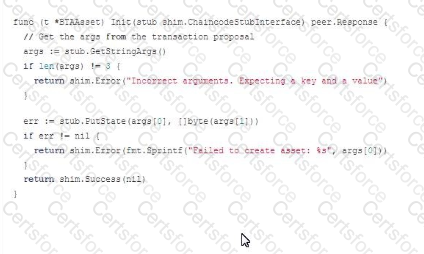Hyperledger fabric business network is divided into which of the following categories?
Hyperledger Explorer is what type of web application? (Select two.)
Level DB is the default database for Hyperledger Fabric and is particularly appropriate when ledger states comprise what type of data?
Which of the following is not a feature of a Hyperledger Fabric ledger?
Business Network Application Model is created in Composer using:
Chaincode Services uses___________________ to host (deploy) the chaincode.
What does Chaincode services in Hyperledger use?
Which of the following is the best answer when reviewing a "Code Invoking Transaction" in Hyperledger Fabric?
What is the best definition of chaincode with Hyperledger?
Which function is not required in Hyperledger Fabric chaincode?
Exhibit.

The function displayed will not return an error if: